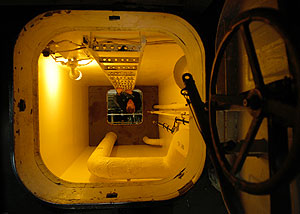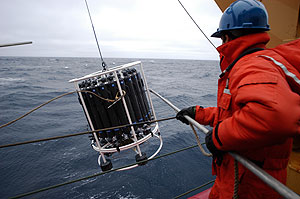|
|
 |
 |
 |
| Ryan Frazier crawls out of the bowels of the ship on the engine room tour. |
Click to enlarge
|
Daily Update
Calendar
Dispatch 24 - September 24, 2004
By C. A. Linder
Weather conditions: Overcast skies, snow flurries, 30
kt winds gusting to 40 kts, 10-12 ft seas, air temperature 31°F
Stormy Seas
A gentle rocking sensation woke me from sleep this morning. I rubbed the sleep out of my eyes and peered out of the porthole at the weather outside. Whitecaps topped the waves all around the ship. The wind was blowing the spray and sleet horizontally across the decks. We were in the midst of our first real arctic storm.
Autumn arctic storms (also known as "polar lows") are as ferocious as New England's winter Nor'easters. The intense low pressure creates unstable air, bringing heavy precipitation and strong winds. The large expanse of open water means that the wind can build up towering swell waves. Waves that started at heights of 5-6 feet in the morning were at times washing over the aft weather deck (15 feet above the waterline!) later in the day. Wave heights exceeding 25 feet are not uncommon at this time of year (check out this dispatch from last year).
 |  |
| Chief Scientist Bob Pickart isn't afraid to get out on the front lines--here he prepares to hook the CTD. |
Click to enlarge
|
Despite the stormy seas, we were determined to complete as much
scientific work as possible. Early this morning we were in position
to study our eddy feature. Our first objective was to map out the
eddy using expendable CTDs (XCTDs, read here for more information).
However, the first probe the watch team launched did not return data.
Neither did the second. After some troubleshooting, the problem was
traced to the cable that carries the data from the probe's copper
wire to the deck unit computer. Since no spare cables were on hand,
the ship's Electronic Technicians repaired the damaged cable. While
that repair took place, we managed to complete a line of regular CTD
casts. We were happy to find the eddy still
here, and larger and stronger than we had originally estimated.
The seas were so rough that boat hooks and
tag lines were employed when the CTD rosette was being brought
back onboard. After several casts in the steadily worsening weather,
Chief Scientist Bob Pickart decided to halt the CTDs. Luckily, that
was when the Electronics Technicians had completed the cable repair.
The XCTDs were back in action thanks to their excellent work, and
just in time.
This afternoon the Engineering Officer, Lieutenant Commander
Reeves, led two tours of the Healy's
engineering compartments. Starting in the bow, just forward of and
below the galley, we worked our way towards the aft (rear) part of
the ship through a maze of passageways
and rooms. We were amazed at the size of the electrical generators
that produce 11.2 Megawatts of power for the ship. That power is used
both to drive the ship's mighty propellers and to service all of the
other electrical needs of the ship. We also gained a new appreciation
for the hard working engineers that keep the ship running smoothly.
In addition to their duties supporting the science operations, the
Healy Marine Science Technicians also forecast the weather. The latest
prediction calls for an increase in storm
intensity overnight, but then settling down somewhat by tomorrow mid-morning.
Bob Pickart has his fingers crossed--if the seas don't abate then
it is likely we will just have to wait out the storm.

|
Traducido al Español por
Andrea
|
Mares tormentosos
Un buen balanceo me desperto de mi sueño esta mañana. Me quite el sueño de los ojos y me asome a la escotilla para ver el tiempo que hacia fuera. Espuma blanca encumbraban las olas alrededor de todo el barco. El viento soplaba y la nevisca corria horizontalmente a lo largo de toda la borda. Estabamos en medio de nuestra primera tormenta artica.
Las tormentas articas de otoño (tambien llamadas “borrascas polares”)
son tan feroces como las del Noreste de Nueva Inglaterra en invierno.
Las bajas presiones intensas crean inestabilidad en el aire, trayendo
fuertes lluvias y vientos. Las largas envergadura de mar abierto pueden
crear mar de fondo de gran magnitud. Las olas que empezaron con 5-6
pies (2-3 metros) llegaron a limpiar la borda de popa por la tarde
olas de hasta 15 pies sobre el nivel mar (5metros). Alturas de ola
de unos 25 pies (8 metros) son normales en estas epocas del año, podeis
mirar el diario del año pasado.
A pesar de el mar tormentoso estabamos decididos a completar cuanto mas trabajo cientifico nos era posible. Esta mañana temprano estabamos ya posicionados para estudiar las caracteristicas de nuestro eddy. Nuestro primer objetivo era posicionar nuestro eddy usando CTDs de usar y tirar (XCTD para mas informacion leer aquí). Pero la primera prueba que hicimos no registro datos, ni la segunda. Despues de disparar unas cuantas veces el problema se encontro en el cable que trasporta los datos desde el hilo de cobre al ordenador de abordo. Dado que no tenian ningun otro cable disponible a mano, los Tecnicos Electronicos del barco repararon el cable dañado. Mientras la reparacion tenia lugar, conseguimos completar una linea entera de CTDs normales. Estabamos contentos de tener el eddy aun alli, mas largo y mas fuerte de lo que originalmente estimamos. El mar estaba tan picado que se tuvieron que emplear cabos con ganchos para conseguir traer la roseta de la CTD a bordo. Tras unas pruebas con el tiempo continuamente empeorando, el jefe cientifico Bob Pickart decidio parar las CTDs. Por suerte esto fue cuando los Tecnicos Electronicos terminaron de reparar el cable. La XCTDs volvieron a funcionar gracias a su excelente ayuda, justo a tiempo.
Esta tarde, el Ingeniero Jefe, Teniente Comandante Reeves, nos guio en un tour por los compartimentos de locomocion. Empezando por la proa, justo delante y debajo del comedor, caminamos hacia popa (la parte trasera) atravesando un laberinto de pasillos y cuartos. Nos sorprendio del tamaño de los generadores electricos, producen 11.2 Megawatios de energia para el barco; para conducir el barco con sus poderosos propulsores como para dar servicio a todas las necesidades electricas. Tambien pudimos apreciar el duro trabajo que llevan a cabo los ingenieros para que el barco siga navegando tranquilamente.
Ademas de la ayuda que prestan al equipo cintifico, los tecnicos de la tripulacion del Healy llevan a cabo el pronostico del tiempo. Las ultimas predicciones anuncian un incremento de las tormentas durante la noche que va a amainar alrededor de media mañana. Bob Pickart tiene los dedos cruzados poque si el mar no se calma seria muy posible que tuvieramos que esperar a que la tormenta pase.
 Previous
Dispatch
Next Dispatch Previous
Dispatch
Next Dispatch

Back to Calendar
|
|




